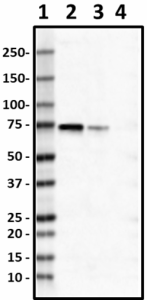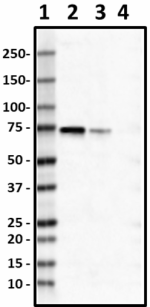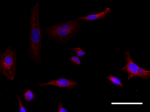- Clone
- A18152B (See other available formats)
- Regulatory Status
- RUO
- Other Names
- E3-14.7K-interacting protein, FIP-2, Huntingtin yeast partner L, Huntingtin-interacting protein 7, HIP-7, NEMO-related protein, Optic neuropathy-inducing protein, Transcription factor IIIA-interacting protein, TFIIIA-IntP
- Isotype
- Mouse IgG2a, κ
- Ave. Rating
- Submit a Review
- Product Citations
- publications

-

Western blot of purified anti-Optineurin antibody (clone A18152B). Lane 1: Molecular weight marker; Lane 2: 20 µg of human brain lysate; Lane 3: 20 µg of A431 cell lysate; Lane 4: 20 µg of HeLa cell lysate (negative control). The blot was incubated with 10 µg/mL of the primary antibody overnight at 4°C, followed by incubation with HRP goat anti-mouse IgG antibody (Cat. No. 405306). Enhanced chemiluminescence was used as the detection system. -

ICC staining of purified anti-Optineurin antibody (clone A18152B) on A431 cells. The cells were fixed with 4% PFA, permeabilized with a buffer containing 0.1% Triton X-100 and 0.25% BSA, and blocked with 2% normal goat serum and 0.02% BSA. The cells were then incubated with 2 µg/mL of the primary antibody overnight at 4°C, followed by incubation with 2.5 µg/mL of Alexa Fluor® 594 goat anti-mouse IgG antibody (Cat. No. 405326) for 1 hour at room temperature. Nuclei were counterstained with DAPI. The image was captured with a 60X objective. Scale bar: 50 µm
| Cat # | Size | Price | Save |
|---|---|---|---|
| 870101 | 25 µg | ¥23,320 | |
| 870102 | 100 µg | ¥60,720 |
Optineurin (OPTN), also known as FIP-2 or NEMO-related protein (NRP), is a cytoplasmic protein associated with diverse cellular functions including membrane trafficking, vesicle transport, and cell cycle control. OPTN has also been identified as an autophagy receptor important in elimination of damaged mitochondria through mitophagy, a selective macroautophagy process. Mutations in the Optn gene have been linked to a variety of disorders including amyotrophic lateral sclerosis, glaucoma, and Paget's disease of bone. In vitro cellular studies suggest that optineurin recognizes various protein aggregates via its C-terminal coiled-coiled domain in a ubiquitin-independent manner and facilitates autophagic clearance of protein aggregates. Immunohistochemical analyses demonstrate the localization of OPTN to pathological tau tangles in Alzheimer's disease tissues, and Lewy bodies and neurites in Parkinson's disease tissues, supporting its role in neurodegenerative diseases.
Product DetailsProduct Details
- Verified Reactivity
- Human
- Antibody Type
- Monoclonal
- Host Species
- Mouse
- Immunogen
- Recombinant human optineurin protein
- Formulation
- Phosphate-buffered solution, pH 7.2, containing 0.09% sodium azide
- Preparation
- The antibody was purified by affinity chromatography.
- Concentration
- 0.5 mg/mL
- Storage & Handling
- The antibody solution should be stored undiluted between 2°C and 8°C.
- Application
-
WB - Quality tested
ICC - Verified - Recommended Usage
-
Each lot of this antibody is quality control tested by western blotting. For western blotting, the suggested use of this reagent is 2.0 - 10 µg/mL. For immunocytochemistry, a concentration range of 2.0 - 10 μg/mL is recommended. It is recommended that the reagent be titrated for optimal performance for each application.
- RRID
-
AB_2820186 (BioLegend Cat. No. 870101)
AB_2820187 (BioLegend Cat. No. 870102)
Antigen Details
- Structure
- Human optineurin is a 577 amino acid protein with a predicted molecular mass of 66 kD and an observed molecular mass of 74 kD.
- Distribution
-
Tissue distribution: Widely expressed in tissues
Cellular distribution: Nucleus, endosome, cytosol, Golgi apparatus, mitochondrion, lysosome
- Function
- Optineurin plays an important role in the maintenance of the Golgi complex, membrane trafficking and exocytosis.
- Interaction
- Interacts with myosin VI and Rab8
- Cell Type
- Astrocytes, Neurons
- Biology Area
- Neurodegeneration, Neuroscience, Protein Misfolding and Aggregation, Protein Trafficking and Clearance
- Molecular Family
- Adaptor Proteins
- Antigen References
-
- Osawa T, et al. 2011. Neuropathology. 31:569-74.
- Ying H, Yue BY. 2012. Int. Rev. Cell. Mol. Biol. 294: 223-58.
- Korac J, et al. 2013. J. Cell. Sci. 126: 580-92.
- Gene ID
- 10133 View all products for this Gene ID
- UniProt
- View information about Optineurin on UniProt.org
Other Formats
View All Optineurin Reagents Request Custom Conjugation| Description | Clone | Applications |
|---|---|---|
| Purified anti-Optineurin | A18152B | WB,ICC |
Compare Data Across All Formats
This data display is provided for general comparisons between formats.
Your actual data may vary due to variations in samples, target cells, instruments and their settings, staining conditions, and other factors.
If you need assistance with selecting the best format contact our expert technical support team.









Follow Us